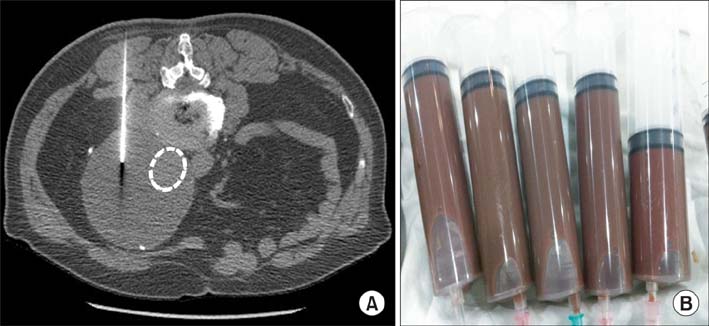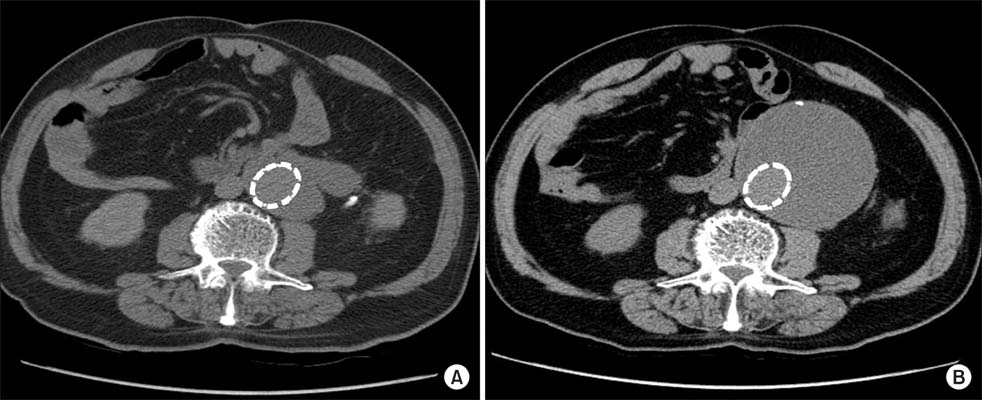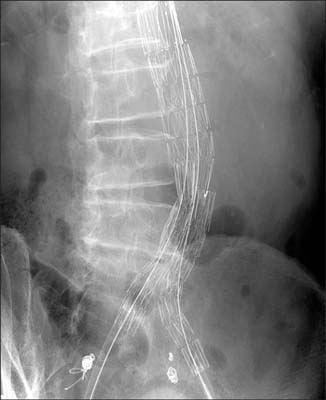Ann Surg Treat Res.
2014 Mar;86(3):161-164. 10.4174/astr.2014.86.3.161.
Relining technique for continuous sac enlargement and modular disconnection secondary to endotension after endovascular aortic aneurysm repair
- Affiliations
-
- 1Department of Surgery, Inha University School of Medicine, Incheon, Korea. keechong@inha.ac.kr
- 2Division of Vascular Surgery, Department of Surgery, Seoul National University College of Medicine, Seoul, Korea.
- 3Division of Vascular Surgery, Department of Surgery, The Catholic University of Korea School of Medicine, Seoul, Korea.
- 4Department of Radiology, Inha University School of Medicine, Incheon, Korea.
- KMID: 2266897
- DOI: http://doi.org/10.4174/astr.2014.86.3.161
Abstract
- Endotension is an unpredictable late complication of endovascular aortic aneurysm repair (EVAR). This case report will discuss the successful treatment of enlarged aneurysmal sac due to endotension using the relining technique. An 81-year-old male complained of nondecreasing huge aneurysm sac. He had undergone EVAR for infrarenal abdominal aortic aneurysm 7 years prior and no endoleak was found through follow-up. Initially computed tomography-guided sac aspiration was tried, but in vain, Relining using the double barrel technique and tubular endograft for modular diconnection, which was unexpectedly found in the original endograft, were performed sucessfully. During follow-up after the relining procedure, the size of aneurysm sac continued to decrease in size. The relining technique is effective mothod for treating endotension.
MeSH Terms
Figure
Reference
-
1. Chaikof EL, Brewster DC, Dalman RL, Makaroun MS, Illig KA, Sicard GA, et al. SVS practice guidelines for the care of patients with an abdominal aortic aneurysm: executive summary. J Vasc Surg. 2009; 50:880–896.2. Moll FL, Powell JT, Fraedrich G, Verzini F, Haulon S, Waltham M, et al. Management of abdominal aortic aneurysms clinical practice guidelines of the European society for vascular surgery. Eur J Vasc Endovasc Surg. 2011; 41:Suppl 1. S1–S58.3. Zarins CK, White RA, Hodgson KJ, Schwarten D, Fogarty TJ. Endoleak as a predictor of outcome after endovascular aneurysm repair: AneuRx multicenter clinical trial. J Vasc Surg. 2000; 32:90–107.4. Gelfand DV, White GH, Wilson SE. Clinical significance of type II endoleak after endovascular repair of abdominal aortic aneurysm. Ann Vasc Surg. 2006; 20:69–74.5. Hobo R, Buth J. EUROSTAR collaborators. Secondary interventions following endovascular abdominal aortic aneurysm repair using current endografts. A EUROSTAR report. J Vasc Surg. 2006; 43:896–902.6. Gilling-Smith G, Brennan J, Harris P, Bakran A, Gould D, McWilliams R. Endotension after endovascular aneurysm repair: definition, classification, and strategies for surveillance and intervention. J Endovasc Surg. 1999; 6:305–307.7. Goodney PP, Fillinger MF. The effect of endograft relining on sac expansion after endovascular aneurysm repair with the original-permeability Gore Excluder abdominal aortic aneurysm endoprosthesis. J Vasc Surg. 2007; 45:686–693.8. Filippi F, Tirotti C, Stella N, Rizzo L, Taurino M. Endotension-related aortic sac rupture treated by endograft relining. Vascular. 2013; 21:113–115.9. Cerna M, Kocher M, Utikal P, Bachleda P. Endotension after endovascular treatment of abdominal aortic aneurysm: percutaneous treatment. J Vasc Surg. 2009; 50:648–651.10. Uthoff H, Katzen BT, Gandhi R, Pena CS, Benenati JF, Geisbusch P. Direct percutaneous sac injection for postoperative endoleak treatment after endovascular aortic aneurysm repair. J Vasc Surg. 2012; 56:965–972.
- Full Text Links
- Actions
-
Cited
- CITED
-
- Close
- Share
- Similar articles
-
- Endotension Following Endovascular Aneurysm Repair: Retrospective Review of Treatment and Clinical Outcome
- Current Management of the Growing Sac after Endovascular Aneurysm Repair
- Novel Technique to Rescue a Folded Aortic Endograft during Endovascular Aneurysm Repair
- Visceral Debranching Thoracic Endovascular Aneurysm Repair for Chronic Dissecting Thoracoabdominal Aortic Aneurysm
- Endovascular Stent-Graft Placement and Secondary Intervention for Abdominal Aortic Aneurysm in a Patient who had a Previously Inserted Iliac Stent





